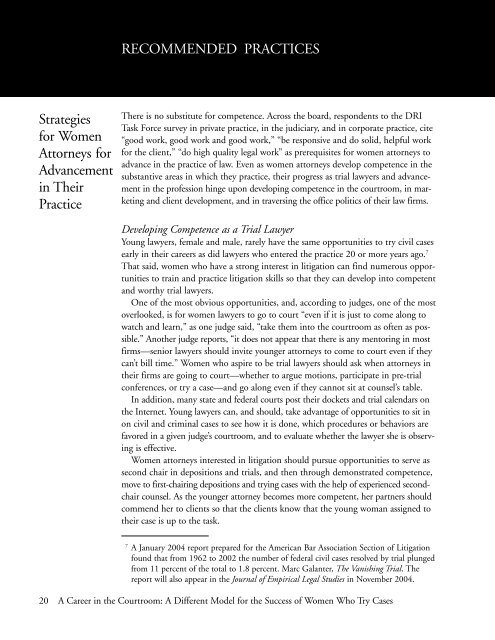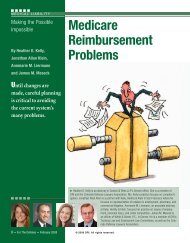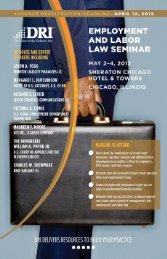A Career in the Courtroom: A Different Model for the Success ... - DRI
A Career in the Courtroom: A Different Model for the Success ... - DRI
A Career in the Courtroom: A Different Model for the Success ... - DRI
You also want an ePaper? Increase the reach of your titles
YUMPU automatically turns print PDFs into web optimized ePapers that Google loves.
Strategies<br />
<strong>for</strong> Women<br />
Attorneys <strong>for</strong><br />
Advancement<br />
<strong>in</strong> Their<br />
Practice<br />
RECOMMENDED PRACTICES<br />
There is no substitute <strong>for</strong> competence. Across <strong>the</strong> board, respondents to <strong>the</strong> <strong>DRI</strong><br />
Task Force survey <strong>in</strong> private practice, <strong>in</strong> <strong>the</strong> judiciary, and <strong>in</strong> corporate practice, cite<br />
“good work, good work and good work,” “be responsive and do solid, helpful work<br />
<strong>for</strong> <strong>the</strong> client,” “do high quality legal work” as prerequisites <strong>for</strong> women attorneys to<br />
advance <strong>in</strong> <strong>the</strong> practice of law. Even as women attorneys develop competence <strong>in</strong> <strong>the</strong><br />
substantive areas <strong>in</strong> which <strong>the</strong>y practice, <strong>the</strong>ir progress as trial lawyers and advancement<br />
<strong>in</strong> <strong>the</strong> profession h<strong>in</strong>ge upon develop<strong>in</strong>g competence <strong>in</strong> <strong>the</strong> courtroom, <strong>in</strong> market<strong>in</strong>g<br />
and client development, and <strong>in</strong> travers<strong>in</strong>g <strong>the</strong> office politics of <strong>the</strong>ir law firms.<br />
Develop<strong>in</strong>g Competence as a Trial Lawyer<br />
Young lawyers, female and male, rarely have <strong>the</strong> same opportunities to try civil cases<br />
early <strong>in</strong> <strong>the</strong>ir careers as did lawyers who entered <strong>the</strong> practice 20 or more years ago. 7<br />
That said, women who have a strong <strong>in</strong>terest <strong>in</strong> litigation can f<strong>in</strong>d numerous opportunities<br />
to tra<strong>in</strong> and practice litigation skills so that <strong>the</strong>y can develop <strong>in</strong>to competent<br />
and worthy trial lawyers.<br />
One of <strong>the</strong> most obvious opportunities, and, accord<strong>in</strong>g to judges, one of <strong>the</strong> most<br />
overlooked, is <strong>for</strong> women lawyers to go to court “even if it is just to come along to<br />
watch and learn,” as one judge said, “take <strong>the</strong>m <strong>in</strong>to <strong>the</strong> courtroom as often as possible.”<br />
Ano<strong>the</strong>r judge reports, “it does not appear that <strong>the</strong>re is any mentor<strong>in</strong>g <strong>in</strong> most<br />
firms—senior lawyers should <strong>in</strong>vite younger attorneys to come to court even if <strong>the</strong>y<br />
can’t bill time.” Women who aspire to be trial lawyers should ask when attorneys <strong>in</strong><br />
<strong>the</strong>ir firms are go<strong>in</strong>g to court—whe<strong>the</strong>r to argue motions, participate <strong>in</strong> pre-trial<br />
conferences, or try a case—and go along even if <strong>the</strong>y cannot sit at counsel’s table.<br />
In addition, many state and federal courts post <strong>the</strong>ir dockets and trial calendars on<br />
<strong>the</strong> Internet. Young lawyers can, and should, take advantage of opportunities to sit <strong>in</strong><br />
on civil and crim<strong>in</strong>al cases to see how it is done, which procedures or behaviors are<br />
favored <strong>in</strong> a given judge’s courtroom, and to evaluate whe<strong>the</strong>r <strong>the</strong> lawyer she is observ<strong>in</strong>g<br />
is effective.<br />
Women attorneys <strong>in</strong>terested <strong>in</strong> litigation should pursue opportunities to serve as<br />
second chair <strong>in</strong> depositions and trials, and <strong>the</strong>n through demonstrated competence,<br />
move to first-chair<strong>in</strong>g depositions and try<strong>in</strong>g cases with <strong>the</strong> help of experienced secondchair<br />
counsel. As <strong>the</strong> younger attorney becomes more competent, her partners should<br />
commend her to clients so that <strong>the</strong> clients know that <strong>the</strong> young woman assigned to<br />
<strong>the</strong>ir case is up to <strong>the</strong> task.<br />
7 A January 2004 report prepared <strong>for</strong> <strong>the</strong> American Bar Association Section of Litigation<br />
found that from 1962 to 2002 <strong>the</strong> number of federal civil cases resolved by trial plunged<br />
from 11 percent of <strong>the</strong> total to 1.8 percent. Marc Galanter, The Vanish<strong>in</strong>g Trial. The<br />
report will also appear <strong>in</strong> <strong>the</strong> Journal of Empirical Legal Studies <strong>in</strong> November 2004.<br />
20 A <strong>Career</strong> <strong>in</strong> <strong>the</strong> <strong>Courtroom</strong>: A <strong>Different</strong> <strong>Model</strong> <strong>for</strong> <strong>the</strong> <strong>Success</strong> of Women Who Try Cases








